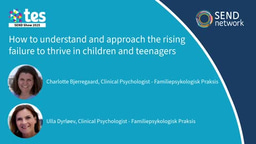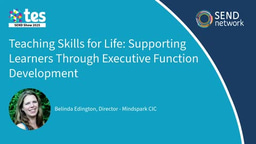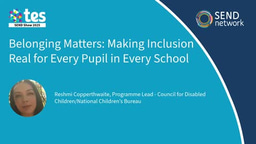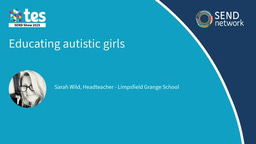Good SEND practice vs good inclusive practice – is there a difference?

At Nursery World’s Big Day Out 2025, Catherine McLeod OBE, Chief Executive of Dingley’s Promise, delivered the opening presentation on the SEND stage, addressing a key question:
Is good SEND practice the same as good inclusive practice, and if not, what is the difference?
Catherine began by highlighting how timely (and perhaps controversial) her presentation was, given the fresh news that the UK government is considering overturning the current system of Education, Health and Care Plans (EHCPs). While Catherine provided specific further explanation on EHCPs later on in her session, the general debate feeds into the presentation's focus: what happens if our practice is extremely SEND focused, without that strong inclusive practice underneath it?
What might SEND practice look like?
Often, the best SEND practice focuses on the individual needs of the child and supporting them in isolation from the rest of the class – relying regularly on one-to-one support. This individual approach can be considered “gold standard”, said Catherine, often ignoring the benefits which forming connections through play and learning can have on the longer term outcomes of a child.
Catherine highlighted that the narrative around the benefits of one-to-one support is so strong that parents might put pressure on early years practitioners to provide this, without understanding the whole picture. It is our responsibility as early years practitioners to explain in an honest way to the parents what the negative side of relying too heavily on one-to-one support might be.
Good SEND practice will also often rely on the involvement of external health professionals, such as speech and language therapists. Although working in strong partnership with other health professionals is fundamental to a child’s support, often practitioners can fall into the trap of waiting for these health professionals to step in before they put any early intervention strategies in place.
So what we really need to focus on is, how does that graduated approach work?” said Catherine. “How do we make sure that we as professionals, valued professionals, are using all of our skills to work with children, to understand the child, to start using strategies, before those professionals actually come in.”
Returning to the opening point around EHCPs, Catherine explained how Dingley’s Promise have been campaigning for a needs-based approach to early years support rather than relying on EHCPs, which requires a diagnosis-led approach. Catherine recognized that for this to happen effectively, a big change needs to be made at reception stage to provide children with the right support to get an EHCP to support them through primary and secondary. However, she argued that the early years practitioner has a unique opportunity to put in place early, tailored and graduated support without forcing parents immediately down a diagnosis route, support which becomes more challenging to implement at later stages of education.
The importance of having honest conversations with parents repeatedly resurfaced throughout Catherine’s talk, including here. Being able to reassure parents that their child’s needs have been identified and are being addressed without necessarily going straight into the EHC assessment process is extremely important.
How might inclusive practice differ from this?
Catherine explained that inclusive practice is centered on learning together. Practitioners can provide specific support and tailored activities where necessary, but without taking children aside from their peers and isolating them in their learning and play experiences.
It is really important that every practitioner, not just the SENCO, but every practitioner in the setting is really confident and strong on inclusive practice, because that is your basis before any SEND practice is put in place”, said Catherine.
Having a clear understanding of strategies which early years practitioners can put in place before a health professional is available to support is a crucial part of the role.
“Really getting to know the individual child and having a toolkit of strategies we can apply as early as possible will mean when the health professionals come along, we can tell them what we have already done and work with them on what has/hasn’t worked. And it’s about communicating this with the family too, in a celebratory way.”
For Catherine, a celebratory approach is an aspect which is often underestimated – in particular, the impact this can have on the family. So often local authority paperwork requires a list of problems or deficits, and this negativity can be felt by families. Celebrating what a child is already doing and can do can make a big difference.
And this isn’t the only area where the narrative needs to be flipped. Often parents will have a fear of mainstream settings, having heard horror stories about how children with SEND have struggled in these environments. Where applicable, it’s important to have an honest conversation with parents carers about the positive side to mainstream settings, reminding them that often the horror stories are the loudest because they are the least common. No-one is going to shout about the times where it went well.
Catherine reminded attendees that ordinarily available provision is key here, and should not just be used to shape practice, but as a tool to demonstrate to parents what the base level of provision should look like for their children – in a lot of cases their needs should be met through this provision in mainstream settings.
We as educators really have to make sure that families understand that there is this basis, and that actually every child should be getting that ordinarily available provision as standard. It's really, really critical”, explained Catherine.
Catherine summarised the key components of effective inclusion as the following:
- Having strong child development knowledge for early identification of needs and what next steps might be
- Conducting honest discussions with parents around early intervention rather than setting them immediately on a diagnosis pathway
- Adopting a graduated approach and getting specialist support at the right time (even though challenging at the moment)
- Forming good relationships with your local health professionals
- Providing transition support – the earlier the better; making sure all the steps are in place even before you know what setting they child is going to
- Building mutual respect with schools – nursery managers need to build strong relationships with local schools to support the transition of children
- Adopting a celebratory approach
“The bottom line” concluded Catherine, “is there is a place for really strong SEND practice with a small group of children. But what we have to understand is that complements what should be really strong, inclusive practice across your whole setting with every child. And that is where we have to focus on using graduated approach, using ordinarily available provision to make sure that every child gets what they need as early as possible.”





Please sign in or register for FREE
If you are a registered user on SEND Network, please sign in